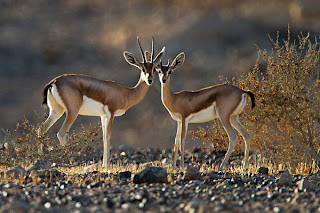 |
| Gazella dorcas |
Dorcas Gazelles thrive in the desert thanks to some great adaptations. They never have to drink actual water, since they can derive all of their needed moisture from the plants that they eat. They also can withstand extreme temperatures and derive their social habits from the harshness of the conditions. When the conditions are rough they tend to live in small groups where there is less competition, but when things are better they will often form small herds consisting of a male, several females, and their offspring.
Males can become incredibly territorial during the mating season, and they mark off their land by creating dung piles. Gestation lasts around 6 months, and typically only one fawn is born at a time. These newborns are very well developed and are able to stand within an hour. Fawns will spend their first few weeks of life hiding out in bushes while their mothers graze. After two weeks they are strong enough to follow their mothers more actively, and they are fulling weaned by three months.
Dorcas Gazelles are currently listed as Vulnerable. Though the species on the whole is widespread, several of the subspecies are becoming rare and threatened due to illegal hunting and habitat loss. Conservation efforts include protection within designated reserves and captive breeding programs.
IUCN Status : Vulnerable
Location : North Africa and the Middle East
Size : Height up to 2ft (.6m), Weight up to 45lbs (20kg)
Classification : Phylum : Chordata -- Class : Mammalia -- Order : Artiodactyla
Family : Bovidae -- Genus : Gazella -- Species : G. dorcas
Family : Bovidae -- Genus : Gazella -- Species : G. dorcas
I had no idea that there are gazelles in the deserts, I mean I have always imagined that they inhabit places close to rivers with wonderful green grass around...
ReplyDeletewow they can stand in a hour!!!!!!!!!!!!!!!!!!!!!!!!!!!!!!!!!!!!!!!!!!!!!!!!!!!!!!!!!!!!!!!!!!!!!!!!!!!!!!!!!!!!!!!!!!!!!!!!!!!!!!!!!!!!!!!!!!!!!!!!!!!!!!!!!!!!!!!!!!!!!!!!!!!!!!!!!!!!!!!!!!!!!!!!!!!!!!!!!!!!!!!!!!!!!!!!!!!!!!!!!!!!!
ReplyDelete